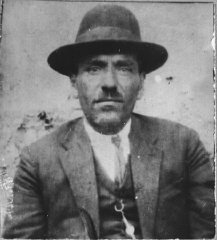|
|

|

|
Portrait of David Aruti, son of Isak Aruti. He was a merchant and lived at Zvornitska 26 in Bitola. See more photographs |
TOWER OF SEPHARDIC FACES: THE JEWISH COMMUNITY OF MONASTIR, MACEDONIA |
||||
|
|
March 11, 2003, marked the 60th anniversary of the World War II deportation of the Sephardic Jewish community of Monastir, historically the largest Jewish community in Macedonia. The Jews who trace their ancestry to the Macedonian city known since 1913 as Bitola continue to call the city by the name it bore during centuries of Ottoman rule: Monastir. Between 1941 and 1944, Bulgaria, in alliance with Nazi Germany, occupied the Yugoslav province of Macedonia. On March 11, 1943, in cooperation with the Germans, Bulgarian military and police officials rounded up 3,276 of Monastir's Jewish men, women, and children, deported them to German-controlled territory and turned them over to the custody of German officials. The Germans transported the Jewish population of Monastir and environs to their deaths in Treblinka as part of their plan to murder all European Jews. |
|
Photographs of nearly every Jewish adult in Monastir, more than half the community, were collected by the Bulgarian authorities in the first half of 1942. These photographs have been preserved and identified and are now available in the Photo Archives of the United States Holocaust Memorial Museum (USHMM) and on this Web site. Though many of the Jewish inhabitants of eastern Europe were required to submit photographs for purposes of police registration, work permits, and ration cards both inside and outside ghettos established by Germany or its Axis allies, few of these photograph collections survived the war intact. The Monastir registration photographs constitute one of these rare collections. Because they have been carefully identified (probably by Jakov Aroesti, one of the few survivors from Monastir, in the late 1950s), they are an extremely valuable historical and genealogical resource. The Monastir photographs offer a uniquely comprehensive view of a Jewish community on the eve of its destruction, reflecting the evolution and demise of Sephardic communities throughout the Balkans. (You may view the photographs by choosing "Browse the collection..." under Related Links at the end of this article). |
|
Origins of the Collection |
|
The origins of the Monastir photograph collection lay in the directive given by the Bulgarian occupation authorities in early 1942 to the Jews of Monastir, then recently concentrated in a ghetto, to submit photographs of all family members above the age of 13. While some of the submitted photos were newly taken for this purpose, others were older family snapshots dating from the 1890s to the early 1940s. Most of the photographs are head shots of individual adults, but some are group portraits of two, three, or more family members. Apparently, these photographs were reproduced by the Bulgarian authorities; one complete set now exists at the Macedonian State Archives, captioned in the 1950s, while another set was cut and pasted into police register books produced by the Bulgarian authorities in 1942. These police registers were recovered after the war and turned over to the Union of Jewish Communities of Yugoslavia. Years later they were donated to Yad Vashem in Jerusalem, but not before a large percentage of the photos were removed by survivors. Arrival of the collection at the United States Holocaust Memorial Museum The Monastir registration photographs were discovered by researchers in the USHMM's International Archival Programs Division (IAPD) in 1996 while surveying Holocaust-related collections in Macedonia. The State Archives of Macedonia graciously granted the IAPD's request to rephotograph the collection for the Museum's Photo Archives, whose mission it is to bring together in a central location copies of important Holocaust related images from public and private sources. The negatives arrived in 1997 along with microfilms of the Serbo-Croatian captions written on the backs of the photos. In the spring of 2001 these captions were translated by Isaac Nehama, a survivor volunteer (originally from Athens) whose parents both grew up in Monastir. Mr. Nehama further correlated the captioning information with both the Yad Vashem Bulgarian police registers and the published “Register of Deportees” in The Jews in Macedonia during the Second World War (1941-1945) by Z. Kolonomos and V. Vangeli. Additional contextual information about the Jewish community of Monastir was obtained from Mark Cohen, author of Last Century of a Sephardic Community: The Jews of Monastir, 1839-1943 (Foundation for Sephardic Studies, New York, NY). CREDITS Text Photographs |
|
|
|